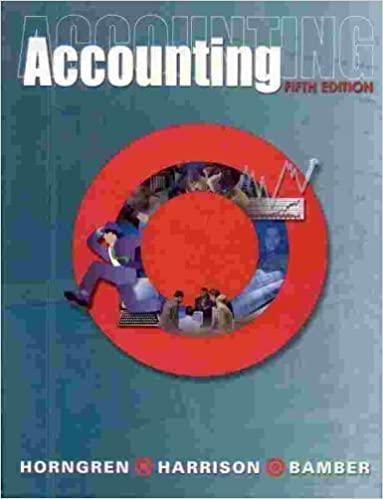Question
1. Advocates of variable costing argue that: a. fixed production costs should be added to inventory because such costs have future service potential and therefore
1. Advocates of variable costing argue that: a. fixed production costs should be added to inventory because such costs have future service potential and therefore are inventoriable as an asset. b. fixed production costs should be capitalized as an asset and amortized over future periods when benefits from such costs are expected to be received. c. Fixed production costs should be charged to the period in which they are incurred unless sales do not equal production in which case any difference should be capitalized as an asset and amortized over future periods. d. Fixed production costs should be charged to the period in which they are incurred
2. Under variable costing, fixed manufacturing overhead is: a. carried in a liability account. b. carried in an asset account. c. ignored. d. immediately expensed as a period cost. 3. When production exceeds sales, the net operating income reported under absorption costing generally will be: a. less than net operating income reported under variable costing. b. greater than net operating income reported under variable costing. c. equal to net operating income reported under variable costing. d. higher or lower because no generalization can be made. 4. In an income statement prepared using the variable costing method, fixed manufacturing overhead would: a. not be used. b. be used in the computation of the contribution margin. c. be used in the computation of net operating income but not in the computation of the contribution margin. d. be treated the same as variable manufacturing overhead. 5. Which of the following is true of a company that uses absorption costing? a. Net operating income fluctuates directly with changes in sales volume. b. Fixed production and fixed selling costs are considered to be product costs. c. Unit product costs can change as a result of changes in the number of units manufactured. d. Variable selling expenses are included in product costs.
6. Under absorption costing, fixed manufacturing overhead costs: a. are deferred in inventory when production exceeds sales. b. are always treated as period costs. c. are released from inventory when production exceeds sales. d. none of these. 7. The type of costing that provides the best information for breakeven analysis is: a. job-order costing. b. variable costing. c. process costing. d. absorption costing. 8. When sales exceed production, the net operating income reported under variable costing generally will be: a. less than net operating income reported under absorption costing. b. greater than net operating income reported under absorption costing. c. equal to net operating income reported under absorption costing. d. higher or lower because no generalization can be made. 9. Which of the following costs at a manufacturing company would be treated as a product cost under both absorption costing and variable costing? Variable Variable Overhead selling and administrative a. Yes Yes b. Yes No c. No Yes d. No No 10. Under absorption costing, product costs include: Fixed factory Variable factory Overhead overhead a. No No b. No Yes c. Yes Yes d. Yes No 11. Under the variable costing: a. net operating income will tend to move up and down in response to changes in levels of production. b. inventory costs will be lower than under absorption costing. c. net operating income will tend to vary inversely with production changes. d. net operating income will always be higher than under absorption costing.
12. In an income statement prepared using the variable costing method, fixed selling and administrative expenses would: a. be used in the computation of the contribution margin. b. be used in the computation of net operating income but not in the computation of the contribution margin. c. be treated the same as variable manufacturing expenses. d. not be used. 13. In an income statement prepared as an internal report using variable costing, variable selling and administrative expenses would: a. not be used. b. be used in the computation of the contribution margin. c. be used in the computation of net operating income but not in the computation of the contribution margin. d. be treated the same as fixed selling and administrative expenses. 14. Which of the following are included in product costs under variable costing? I. Variable manufacturing overhead. II. Fixed manufacturing overhead. III. Selling and administrative expenses. a. I, II, and III. b. I and III. c. I and II. d. I. 15. A single-product company prepares income statements using both absorption and variable costing methods. Manufacturing overhead cost applied per unit produced under absorption costing in year 2 was the same as in year 1. The year 2 variable costing statement reported a profit whereas the year 2 absorption costing statement reported a loss. The difference in reported income could be explained by units produced in year 2 being: a. Less than units sold in year 2. b. Less than the activity level used for allocating overhead to the product. c. In excess of the activity level used for allocating overhead to the product. d. In excess of units sold in year 2.
Step by Step Solution
There are 3 Steps involved in it
Step: 1

Get Instant Access to Expert-Tailored Solutions
See step-by-step solutions with expert insights and AI powered tools for academic success
Step: 2

Step: 3

Ace Your Homework with AI
Get the answers you need in no time with our AI-driven, step-by-step assistance
Get Started


